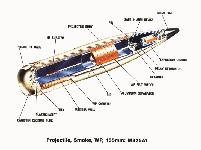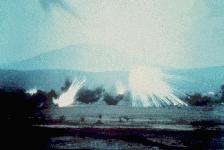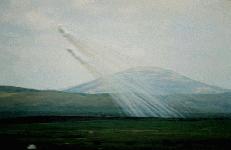(original) (raw)
Smoke projectiles are used for smoke screens, obscuring smoke, and marking targets for aircraft.
The three types of smoke projectiles areas follows:
(1) Hexachloroethane. Hexachloroethane (HC) smoke (smk) projectiles are available for 105-mm and 155-mm howitzers. They are used for screening, obscuration, spotting, and signaling purposes. The projectile has no casualty-producing effects. This base-ejection projectile is ballistically simailar to the HE projectile. It is fitted with a mechanical time fuze M565 or M577. The round expels smoke canisters that emit smoke for a period of 40 to 90 seconds.
(2) Burster-type white phosphorus. White phosphorus projectiles are available for 105-mm and 155-mm howitzers. They are bursting-tube type projectiles that can be fired with point-detonating (PD) or MTSQ fuzes. The projectile has an incendiary-producing effect and is ballistically similar to the HE projectile. Normally, shell WP is employed for its incendiary effect. The projectile also can be used for screening, spotting, and signaling purposes.
(3) M825 white phosphorus. The M825 WP projectile is an FA-delivered 155-mm base-ejection projectile designed to produce a smoke screen on the ground for a duration of 5 to 15 minutes. It consists of two major components--the projectile carrier and the payload. The projectile carrier delivers the payload to the target. The payload consists of 116 WP-saturated felt wedges. The smoke screen is produced when a predetermined fuze action causes ejection of the payload from the projectile. After ejection, the WP-saturated felt wedges in the payload fall to the ground in an elliptical pattern. Each wedge then becomes a point or source of smoke. The M825 is ballistically similar to the M483A1 (DPICM) family of projectiles.
Employment. Smoke is employed by using the quick smoke and immediate smoke techniques.
(1) Quick smoke. A quick smoke mission is used to build a screen 100 to 1,500 meters in length, depending on the munition selected. It may be fired as a preplanned target or as a target of opportunity. Targets greater than 250 meters in length should be preplanned because of ammunition constraints and the possible need to segment the target. Quick smoke may be processed as an adjust-fire or FFE mission. Accurate FFE mission processing on preplanned targets presupposes a positive correlation between wind direction at the screen location and that listed on line 00 of the current computer met message, in addition to meeting the five requirements for accurate predicted fire. The following is a list of quick smoke mission characteristics.
- Delivery technique: Quick smoke.
- Type of target: Planned, or target of opportunity, 100 to 1,500 meters.
- Number of howitzers: 2 to 16.
- Type of ammunition: M825, HC or WP.
- Sheaf: Linear.
- Obscuration Time: 5 to 15 minutes.
- Command and Control: Approval of maneuver commander.
(2) Immediate smoke. An immediate smoke mission may be fired as a separate mission or as a follow-up to immediate suppression. Immediate smoke missions normally are fired by platoon. The initial volley may be fired with shell WP, fuze quick, or a mix of shell WP and shell HC. If additional volleys are fired, all howitzers should fire HC smoke. When firing the M825 smoke round, all howitzers should fire the M825 projectile for the initial and any subsequent volleys. Unit SOP should dictate the number of volleys and which howitzers will fire WP and which will fire HC smoke, if applicable. The following is a list of immediate smoke mission characteristics.
- Delivery technique: Immediate smoke (point suppression). The immediate smoke technique can be used in an immediate suppression mission on a target of opportunity by unit SOP. A mix of WP and HC normally will follow the initial suppression rounds when immediate smoke is requested.
- Type of target: Point or small area of 150 meters or less.
- Number of howitzers: One platoon.
- Type of ammunition: First volley, WP and/or HC; subsequent volleys, HC; or all volleys M825 smoke.
- Sheaf: Parallel.
- Obscuration time: 30 seconds to 5 minutes.
- Command and control: By SOP and/or approval of maneuver commander.
### Quick Smoke
Quick smoke missions are fired by using linear sheafs and TGPCs or special corrections. Depending on the atmospheric conditions and the type of smoke desired, the FDC may need to determine two sets of firing data--one set for the initial rounds and one set for the sustainment rounds. The initial rounds establish the smoke screen, and the sustainment rounds ensure the smoke screen is in place for the desired duration.
For the FDC to provide an effective smoke screen, the FDO needs to obtain additional information not normally provided for other missions. From the observer, the FDO needs the following:
- The center grid of the desired smoke screen. The FDC will compute offset aimpoints on the basis of the type of munition, wind speed, and/or wind direction.
- The length of the smoke screen.
- The maneuver target (MT) direction. The direction from the point at which the maneuver element will be most susceptible to enemy observation to the target.
- Wind direction in reference to the maneuver target line. The observer must let the FDC know if the wind is a head wind, tail wind, left crosswind, or right crosswind in relation to the maneuver target line.
- The screen time (duration), in minutes.


